|
Sixty
years of Suzette
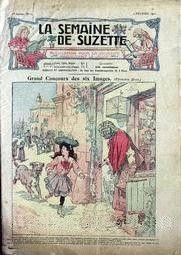
The first Suzette n. 1, 1905
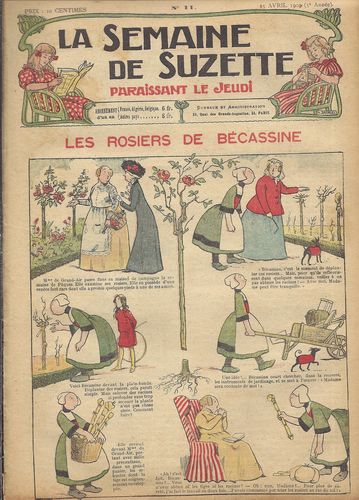
1909
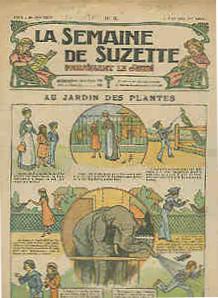
1915
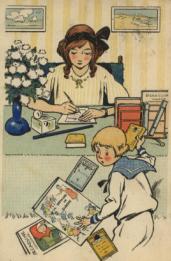
Subsscription
card (front)
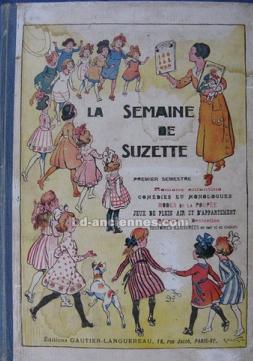
Album
1925
Cover by R de la Nezière
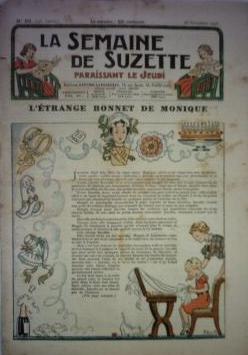
1936
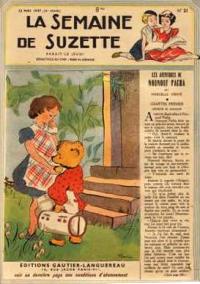
1948
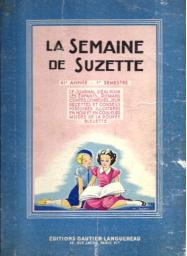
Album1948
cover by Manon Iessel
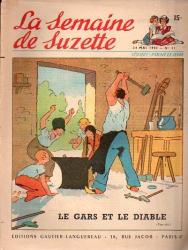
1951
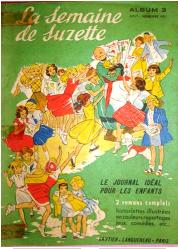
Album
1951
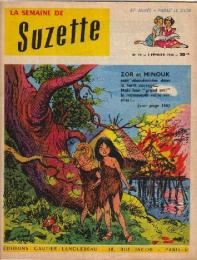
1956
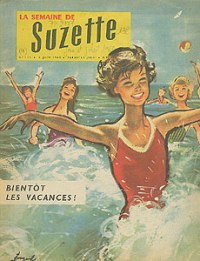
n.
2 June 1960
...mais il n'y aura pas de rentrée
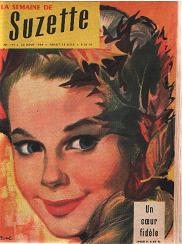
The
last Suzette cover
25 August 1960
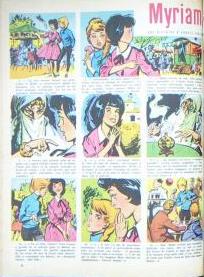
La
Semaine de Suzette
1959-1960
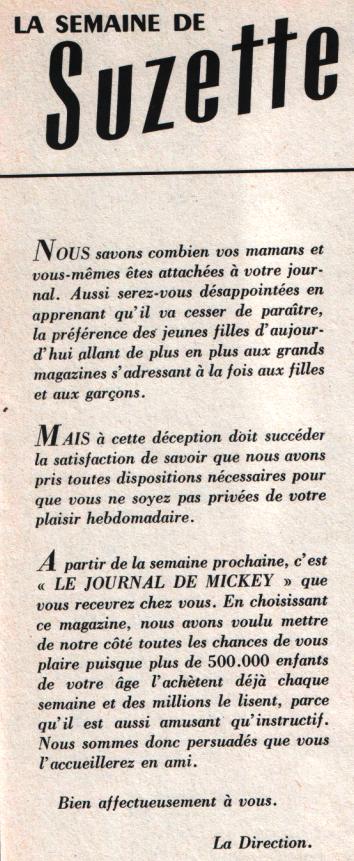 Adieu!
Adieu!
|
From La Semaine de Suzette
to BIBLIOTHÈQUE DE SUZETTE
Les
Petites Filles Bien Sages
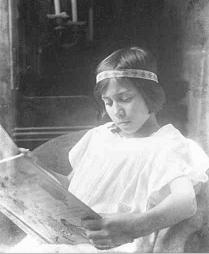
Dominique Rolin
Photo Jean Rolin, 1924
courtesy ©François Nielsen |
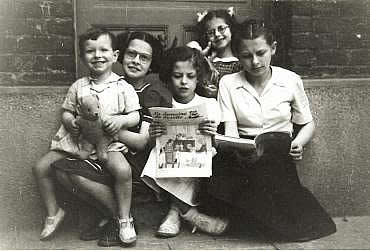
A charming family group with an attentive Suzette reader
courtesy JMC©1950
|
|
Bibliothèque
de Suzette is a children's book collection published
in France between 1919 and 1965 by the publisher Gautier
& Languereau. Its existence is strictly interconnected
with that of La Semaine de Suzette. In fact
all the books of the collection started life as feuilletons
in La Semaine de Suzette, a French illustrated
weekly for well-to-do little girls, published by the same
publisher from February 2nd 1905 until June 6th 1940 and
from May 30th 1946 to August 25th 1960.
Each issue of La Semaine, which was aimed
at an age range of 8-14, contained short stories, an episode
of a serialized novel, an agony aunt column, games, cookery
recipes, sewing patterns for the wardrobe of the doll
Bleuette, a stylish French grand'mama of the yet to be
born Barbie, competitions, crosswords, good manners and
fashion features, in short anything deemed indispensable
to make a proper little girl blossom into a proper grown
up Madame, supporting manners, principles and ideals of
the middle class milieu to which the readers belonged.
It carried some discrete and tasteful advertising. By
today's standards, it was a most gloriously politically
incorrect magazine... Et alors!?... To paraphrase Larkin,
“political correctness began well after nineteen-sixty-three”.
Witness the alluring poise of M.lle Dominique Rolin, born
1913 in a well-to-do Belgian family caught by her father
Jean reading La Semaine de Suzette in this
delightful photo circa 1924. (Courtesy Prof. François
Nielsen, University of North Carolina, Miss Rolin's nephew)
and the enchanting group of five little French brothers
photographed (Suzette warrants!) on the 1st of June 1950.
|
|
Amongst
its readers La Semaine could boast children
who became famous such as Michèle Morgan, André
Malraux, Jeanne Moreau, Troyat, Sylvette Baudrot, Barjavel
and others who in later years reminisced fondly about
Suzette in books or interviews. On the other hand, Simone
de Beauvoir relates in her memoirs that while the majority
of children in her milieu read La Semaine,
she had a subscription to L'Etoile Noëliste
which her mother considered «d'un niveau moral plus
élevé». As for Dominique Rolin, she
became the acclaimed writer of more than forty books (see
BNF). Suzette had also two royal readers: the English
Princesses Elizabeth and Margaret Rose. In July 1938 their
governess Marion Crawford (the infamous Crawfie) subscribed
for a year to La Semaine de Suzette through
a London bookshop.
|
| |
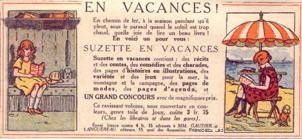 For
those long summer terms, 1924
For
those long summer terms, 1924 |
 Bécassine
is the copyrighted property of
Bécassine
is the copyrighted property of
©Hachette Livre/Gautier Languereau |
One
of the most interesting features of La Semaine
is the agony aunt columns, edited in succession by:
Tante Jacqueline (Jeanne Spallarossa, Mme Alexandre Bernhardt,
the very first aunt). Wrote under the pseudonym of Jacqueline
Rivière
Tante Rolande (Mme Rolande Le Brun, born in 1880 in Paris,
employed at G&L, in charge of advertising, a stopgap
agony aunt, also wrote some features including the on on
good manners as Edna Lor. She remained at La Semaine
until her death in 1939.
Tante Alice (Alice Piguet, b. 1 Sett. 1901 in Nîmes,
aka Alice de Chavannes, pseud. of Alice Pourcherol, a Law
graduate rapporteur à la Commission de contrôle
de la Presse Juvénile). She became a writer inspired
by Mme de Ségur. Prix Jeunesse 1945 for Le jardin
de Thérèse.
Tante Mad (Madeleine Giraud)
Tante Mireille (Géneviève Néranval,
she started working as a secretary for Jean Valmy-Baysse
Secrétaire Général de la Comédie
Française, collaborated with the writer Madeleine
Chaumont and became a brilliant poet and writer) and the
last, another
Tante Jacqueline (Jacqueline Gaillard born 1934, who eventually
became editor-in-chief at Les Veillées des Chaumières).
After more than eighty years, the advice given to the little
Suzettes makes appalling or appealing reading (whichever
side of the divide one happens to be) all based on submission,
blind obedience, reverence towards parents, through the
complete annihilation of a child's personality, which —
the message is — can only be moulded by the experience
of the grown-ups, on middle class models of behaviour. This
is what Tante Rolande replies, on 16 December 1926 to a
rebellious (and hapless) Libellule Verte, aged 14, who is
asking for Tantine's help to convince her parents to let
her: —1) change her first name (didn't we all wish
to re-invent ourselves at 14?); — 2) cut her plaits;
— 3) go out without nanny. Not totally unreasonable
desires for a girl of 14, one would imagine. Tantine's answer
is a devastating blow to poor Libellule's hopes:
Hélas!
ma pauvre petite Libellule, Je suis loin de partager
vos idées. Je les trouve même blâmables...
Je me demande où vous pouvez avoir gagné
de telles pensées d'indépendence...et
pourquoi vous osez supposer que je suis capable de vous
donner raison... Pauvre petite fille!... Vous vous coyez
assez grande, à quatorze ans, pour vous diriger
seule... Eh bien vous vous trompez. Une jeuen fille
n'est jamais assez raissonable pour se libérer
de l'autorité des siens: Elle a toujours besoin
des conseils avisés de paroles sensées
de vigilance active à ses côtés.
Elles doit se soumettre sans répliquer et sans
révolte, aux exigeances des siens.
Though
highly prolific and successful in the genre — some
winning prestigious literary prizes — with a few
exceptions little is known about Suzette's authors who
fell into more or less deserved oblivion. At first glance
Suzette's writers, editors and columnists — basically
an in-house female team — seem upper class or aristocratic
women (their surnames are prefixed by a profusion of "de")
who had received some sort of education, proto-feminists
unhappy to be just glorified housewives. In reality the
majority were middle-class "girls of slender means",
more or less obliged to use their talent to earn a living
or subsidize teaching jobs.
Most were spinsters. Ashamed of their writing — any
money making activity being socially unacceptable for
a woman of the time — they hid under impenetrable
male pseudonyms and were exploited shamelessly by their
publishers (for instance G&L owned the copyright of
all its authors, except Marie Delly's) who dumped them
when their style went out of fashion. Many died in abject
poverty.
The matter of the authors' identities was raised by Anne
des Déserts who in 2001 wrote to Les Veillées
des Chaumières, (the big sister of La
Semaine still going in 2012):
«
Les auteurs, les illustrateurs de La Semaine de Suzette
m'intéressent. Qui étaient-ils ? Des femmes
seules qui écrivaient pour gagner leur vie, des
mères de famille qui avaient envie d'écrire,
des professionnels ? Etaient-ce des salariés, attachés
à la rédaction, ou bien des personnes qui
travaillaient à la vacation ou au contrat ? Comment
choisissait-on les manuscrits ? etc. »
Surely
no Balzacs, yet they write in an elegant polished French,
still readable today. What made them fade into obscurity
is certainly the context of their stories depicting the
way of life of a limited section of society "univers
de marquises et de baronnes menant grand train grâce
à leurs rentes et à leurs fermages, et servies
par une foule de domestiques" (cit. Hachette Jeunesse
website) which started to disappear in 1914, its conduct
dictated by strong Catholic principles, the result too
anachronistic for a modern reader. However one feels that
if not for their literary merits they should have been
remembered for their contribution to the social history
of the times.
One of Gautier&Languereau's authors who stood the
test of time and was financially successful is Berthe
Bernage: catholic, grande-dame of good manners, editor
at Les Veillées des Chaumières, contributor
to La Semaine, she created the character
of Brigitte who first saw the light in 1925 as a serial
in Les Veillées. Published in book format,
Brigitte's adventures lasted 35 years following the protagonist
from adolescence to maturity and are still very much in
print and on sale. Bernage who was unmarried, remained
tied to G&L all her life, published in their various
collections and on her death she made them her heirs.
On the other hand, the illustrators, who much contributed
to the success of Suzette, famous artists such as Avélot,
Thiriet, Morin, Berty, Lorioux, Giffey, Le Rallic, Raffin,
Zier, active in the artistic movements of the XX Century,
not just as children illustrators saw a revival in the
Sixties becoming even more famous with the passing years,
their work highly collectible.
In the first issue of La Semaine was born,
almost by accident, one of the most enduring long lasting
characters of the French bande dessinée: Bécassine,
the Disaster Maid, the Queen of Malapropism, who continuously
misunderstood her mistress' orders with hilarious results,
interpreting life according to her own philosophy of little
paysanne Brétonne.
«Pour
quelles raisons La Semaine de Suzette est-elle incontestablement
le premier périodique du genre?» — asks
Polybiblion: Revue bibliographique universelle in 1920
— «Ces raisons sont multiples. D'abord elle
comporte des illustrations fort nombreuses, en couleurs
et en noir, très variées et très
vivantes: les enfants aiment les images; leurs parents
aussi, du reste. Puis le texte est irréprochable
au double point de vue moral et religieux. Ajoutons que
la note patriotique résonne fréquemment
dans cet ensemble toujours attachant».
These multiple good reasons were going to last another
forty-five years.
|
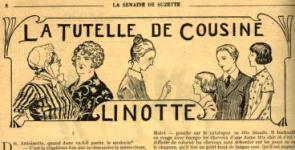 The
first episode of
The
first episode of
La Tutelle de Cousine Linotte
by Berthe Bernage in
La Semaine de Suzette 3rd August 1926.
|
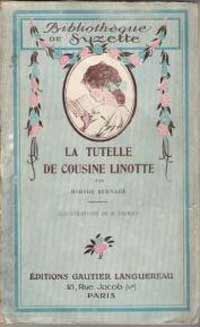 The
book version 1931
The
book version 1931
|
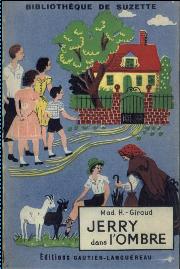 Jerry
dans l'Ombre by M. Giraud
Jerry
dans l'Ombre by M. Giraud
in La Semaine de Suzette, May 1946 and in
Bibliothèque de Suzette, 1948.
|
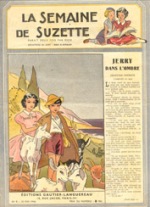 Jerry
dans l'Ombre was the novel serialised in
La Semaine when it reappeared in a four pages
format after the war in May 1946: "Un événement
important pour toutes les petites filles ! Après
six ans d'interruption La Semaine de Suzette
reparait provisoirement deux fois par mois"
Jerry
dans l'Ombre was the novel serialised in
La Semaine when it reappeared in a four pages
format after the war in May 1946: "Un événement
important pour toutes les petites filles ! Après
six ans d'interruption La Semaine de Suzette
reparait provisoirement deux fois par mois"
|
|
|
Not all Suzette feuilletons were published in volume,
for instance (in brackets the year in which some were
serialized): Le Charmeur des serpents, Léon Lambry
(1919); A la conquète de l'Atlas, Myriam Catalany
(1919); Les Péripéties des petites Dalsie,
P. Bresbre (1920); Une bien bonne idée, G. Louza
(1929); Musette, M. de Carnac (1929); La Petite fille
de Sainte-Hélène, E. de Cys et J. Rosmer
(1929); Histoire véridique de M.me Chelmi et de
son chat, P. Perrault (1929).
La Semaine has become the subject of a number
of books and graduation papers (Thèse de Doctorat
or Maîtrise). The vast narrative body of La
Semaine is a fertile ground for a sociological
or historical analysis of many aspects of life during
the sixty years of its existence, to name a few: means
of transport, fashion, food, games, holidays, war, religion,
homes, etc.
La
Semaine de Suzette dans l’entre-deux-guerres,
VINCENT Véronique, Maîtrise, Histoire, Université
de Paris X- Nanterre.
La Semaine de Suzette ou le Journal des petites filles
bien élevées, COUDERC Marie-Anne, Université
de Toulouse Le Mirail, 1992
La représentation de la première guerre
mondiale dans les histoires en images de deux grands périodiques
pour enfants: L'Epatant et La Semaine de Suzette (1914-1918),
PALUEL-MARMONT Julie, 1999, Université François
Rabelais-Tours
L'influence de la Grande Guerre sur un illustré
pour enfants: La Semaine de Suzette (1905-1918), GARDENER
Thierry, 1994, Université de Paris X-Nanterre
La Semaine de Suzette: sources et lectures, GAUCHET-PLAT,
Hélène, Maîtrise Lettres, Université
de Paris X-Nanterre
Mme Couderc has also published two books on La Semaine:
Bécassine inconnue, CNRS ÉDITIONS,
2000
La Semaine de Suzette, Histoires de filles, CNRS
ÉDITIONS, 2005
La
petite poste
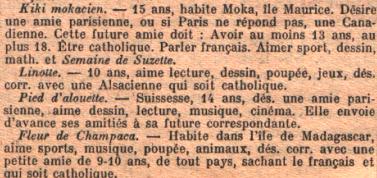
only «Cathol.
bon. famille» need reply.
(La Semaine de Suzette no 39, 27 Sept.
1928)
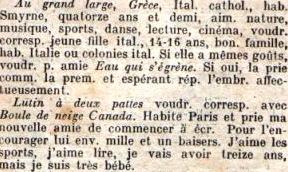
Twenty
four years on... and...
«Cathol. bon. fam» pen-pals are still
de riguer
(La Semaine de Suzette, 1952)
|


Abstract
from: Storia della Biblioteca dei Miei Ragazzi
by Anna Levi,
Pontedera, Bibliografia e Informazione, ©Anna Levi,
2012.
|
|